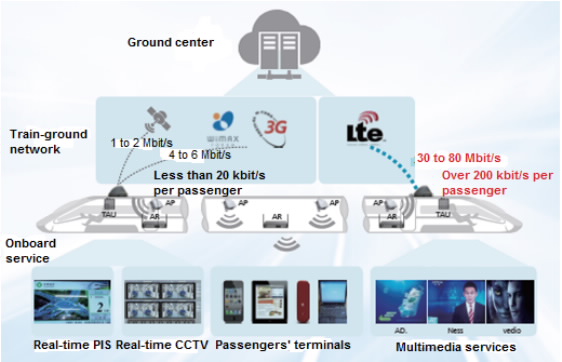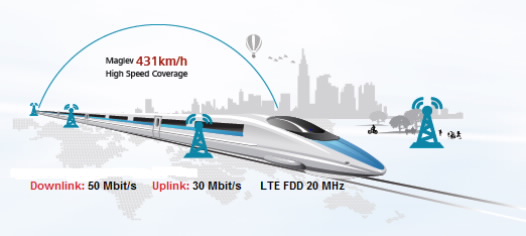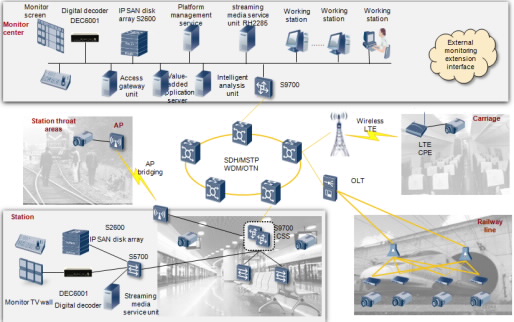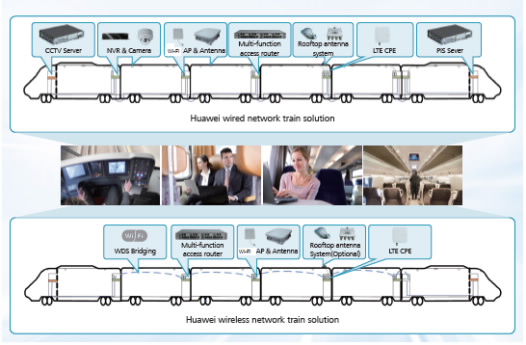Tránsito masivo inteligente
Considering the running scenario of trains, Huawei's digital train solution uses advanced LTE wireless communications technologies to securely integrate fast-moving trains, ground networks, and management centers and provides the video surveillance system to ensure the public security. In addition, it also provides the passenger information system (PIS) to effectively guide passengers and provides Wi-Fi networks for passengers.
Demands and Challenges
With the development of transport, people have more choices for a trip. Traveling is no longer to move from one place to another. More and more demands need to be satisfied for passengers during the traveling. Operating at higher speeds than buses and offering more comfortable space than airplanes, rails are playing an important role in traveling. However, due to the increasing number and new demands of passengers, the metro operation department is facing the following challenges:
- How to ensure the public security because of large amounts of passengers
- How to let the commanding center know the onsite conditions and evacuate passengers after the train gets faulty
- How to get rid of the boredom and weariness in a long-term trip for passengers
- How to let passengers continue their business while traveling
In addition, the following features are provided in the fast-moving train, which enhances the benefits and competition of railway transport and improves the passengers' satisfaction:
- Video surveillance, which guarantees the public security
- Real-time information of passengers, by which passengers can be effectively guided
Solution
Considering the fast-moving feature of trains, Huawei provides a digital train solution for operators by applying global leading communication technologies. This solution improves user experience of passengers. Figure 2-1 shows the solution.

Figure-1 Overview of Huawei Digital Train Solution
The solution consists of the following parts:
Onboard service: The IP network is used to carry the PIS, video surveillance, and passengers' Internet surfing services. Rich multimedia services on board are provided. In addition, wireless networks with a wireless bridge or wired networks can be used to support newly deployed trains or reconstructed trains.
Train-ground wireless communications network: It provides reliable and high-bandwidth channels for services on board and is the key to provide high-quality application services on trains.
Ground center: It provides large amounts of processing resources required by various services and routers, switches, and security devices to access the Internet. It also manages all services in the network and remotely manages and maintains the devices.
High Bandwidths of the Train-to-Ground Wireless Network in the Fast-moving Train

Figure-2 Train-to-Ground LTE communication at high-speed train scenario
Requirements
In a fast-moving train, the train-ground wireless network may become unstable, call drops occur, and the network is interrupted. These problems restrict operators to provide more services in the train. Huawei LTE wireless network that has been validated in the high-speed maglev can solve these problems. Key technologies applied in Huawei LTE wireless network are as follows:
- Automatic frequency control (AFC) technology specified for railways: This technology overcomes the Doppler effect and ensures the wireless link quality on fast-moving trains.
- Frequency deviation-based handover technology: This technology improves the handover success rate based on the frequency deviation.
- Technology of deploying multiple RRUs in one cell: This technology reduces delays, jitters, and packet loss rate caused by handovers to ensure stable bandwidths during high-speed handovers.
- Distributed base station solution: This solution solves the coverage problems between tunnels or bridges.
- Telecommunication-class networks
- Unified network management platform
The train-ground wireless mobile communications network provides high bandwidths and ensures seamless roaming for passengers' terminals. Therefore, the system provides high-quality networks in a slow-moving train.
In addition, GSM, UMTS, and WLAN networks are provided for extension so that customers can quickly evolve train-ground networks into LTE networks by using current resources.

Figure-3 Digital Train solution topology diagram
Rich Onboard Informationization Services

Figure-4 Different solutions for new Train and running train
With the increase of onboard services, higher demands are proposed for the informationization of devices in carriages. Huawei's onboard solution provides a wide range of services such as video surveillance, PIS, and Wi-Fi networks. Based on the real-time data interaction between the train-ground gateway and the ground wireless network, the onboard Ethernet is conducted by using multi-function access routers (ARs) to ensure the high-bandwidth access required by all services. The wired network solution is suitable for the new train to provide services before the train are delivered, and the wireless network solution is available for the running train to easily deploy onboard networks.
The onboard video surveillance system collects the videos both in carriages and cabs. The video data can be sent to the multimedia servers in cabs at both ends of the train at the same time through networks on the train, and the video data can be shown on the LCD screen in the ground center. When an emergency or accident happens, the drivers in cabs and the personnel in the ground command center can immediately switch over to the video showing the emergency or accident to monitor its status. Then, they can take actions to secure passengers' lives and properties.
The real-time PIS ensures that passengers can get the arrival information, the latest infotainment, and the latest multimedia contents in the PIS screen. In addition, the ground command center can know the carriage status through the PIS and broadcast the dispatching information to avoid huge security risks in case of emergency.
Huawei's onboard Wi-Fi network solution reasonably plans wireless network frequencies to meet passengers' Internet surfing requirements through Wi-Fi networks, avoid the interference to existing wireless systems, and ensure the running efficiency of the train. In addition, the solution is used to deploy dual-band access points (APs) in the train, which effectively and economically provides external communications channels for the train. These APs are managed by the access controller (AC), which ensure the high reliability of networks. The onboard AR provides rich multimedia and has 500 GB storage capacity to satisfy passengers' demands.
The QoS policy fulfills the Internet access requirements of business passengers with multi-level QoS services and ensures the network quality when large amounts of customers access the Internet together. The QoS policy that meets the auditing requirements of passengers' behaviors from the Ministry of Public Security of PRC also can ensure the network security.
To allow passengers to surf the Internet when waiting for a train, Huawei also provides the Wi-Fi network coverage solution for platforms by using the current trackside transmission networks.
Train and Ground Management Center
Huawei provides a full range of servers and storage devices to support large-capacity calculation of the ground storage and management data. In the management center, the unified maintenance and management is deployed for the PIS, the real-time control and display as well as unified data storage are deployed for the video surveillance system, and the stable Internet access entry is provided in the center. Based on Huawei eSight network management platform, the management center manages all devices deployed in carriages, around trackside, on platforms, and in the management center. The management center also can operate and maintain devices remotely, thereby reducing OM costs and improving the network operation efficiency.
Why Huawei's Digital Railway Solution
Advanced communications technologies can be used to securely integrate fast-moving trains, ground networks, and management centers, only when these technologies take effect. As a leader in the network and communications industry, Huawei solves problems for customers, ensures the running security of trains, and brings comfortable experience to passengers by using Huawei's advantages in wireless and wired network technologies and rich experiences in the rail transport business.
In addition to the achievements in train-ground transmission networks, the deployment of cables between tunnels, and the support of fast-moving train scenario, Huawei's advanced LTE networks has the following achievements:
- High-bandwidth train-ground network: Ensures a stable bandwidth of 50 Mbit/s on a fast-moving maglev train at the speed of 431 km/h.
- Precise network management: Provides nine QoS levels to ensure the separation between the management data and the service data and guarantee the security of key data, and manages the user-level network quality to improve passengers' Internet surfing experience.
- Stable and distributed onboard platform: Provides the integrated AC in the onboard AR, thereby realizing the distributed management of onboard APs. In this way, the networks in the train can still work properly when the train-ground network becomes unstable.
- Unified maintenance and easy management: All devices can be managed by Huawei eSight that is deployed remotely.
Huawei's digital train solution can meet the train informationization requirements. Together with experienced local partners, Huawei provides all-round support to achieve the expected reliability, security, and performance. Huawei's digital train solution is worth of your trust and can help you to succeed.
